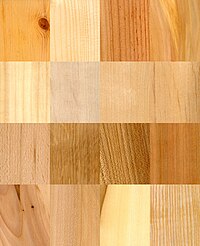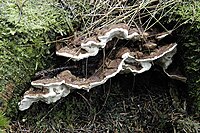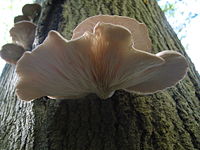
Contribution of fungal and invertebrate communities to wood decay in tropical terrestrial and aquatic habitats.
Sign Up to like & getrecommendations! Published in 2020 at "Ecology"
DOI: 10.1002/ecy.3097
Abstract: Wood is a major carbon input into aquatic ecosystems and is thought to decay slowly, yet surprisingly little terrestrial carbon accumulates in marine sediments. A better mechanistic understanding of how habitat conditions and decomposer communities… read more here.
Keywords: invertebrate; estuarine marine; wood decay; marine habitats ... See more keywords

The influence of migratory Paraburkholderia on growth and competition of wood-decay fungi
Sign Up to like & getrecommendations! Published in 2020 at "Fungal Ecology"
DOI: 10.1016/j.funeco.2020.100937
Abstract: Abstract Certain bacteria are capable of migrating along fungal hyphae, using them as a dispersal mechanism to cross otherwise-prohibitory distances. Three strains of fungal-migratory Paraburkholderia were isolated from the mycelium of wood-decay fungi, and inoculated… read more here.
Keywords: decay fungi; migratory paraburkholderia; wood decay;

Carbon and nitrogen acquisition strategies by wood decay fungi influence their isotopic signatures in Picea abies forests
Sign Up to like & getrecommendations! Published in 2021 at "Fungal Ecology"
DOI: 10.1016/j.funeco.2021.101069
Abstract: Abstract We examined whether sporocarp carbon and nitrogen isotope ratios (δ13C and δ15N values) reflected different functional strategies in 15 species of wood decay fungi. In Finnish Picea abies forests, we compared sporocarp δ13C and… read more here.
Keywords: wood decay; white rot; rot; decay fungi ... See more keywords

Characterization of Fungi Associated With Wood Decay of Tree Species and Grapevine in Greece.
Sign Up to like & getrecommendations! Published in 2017 at "Plant disease"
DOI: 10.1094/pdis-12-16-1761-re
Abstract: A two-year survey was conducted to identify fungi associated with wood decay in a range of tree species and grapevine. Fifty-eight fungal strains isolated from plants of 18 species showing typical wood decay symptoms were… read more here.
Keywords: associated wood; wood; wood decay; tree species ... See more keywords

Metabolic responses of two pioneer wood decay fungi to diurnally cycling temperature
Sign Up to like & getrecommendations! Published in 2021 at "Journal of Ecology"
DOI: 10.1111/1365-2745.13716
Abstract: Decomposition of lignin‐rich wood by fungi drives nutrient recycling in woodland ecosystems. Fluctuating abiotic conditions are known to promote the functioning of ecological communities and ecosystems. In the context of wood decay, fluctuating temperature increases… read more here.
Keywords: wood decay; wood; diurnally cycling; temperature ... See more keywords

Gene family expansions and transcriptome signatures uncover fungal adaptations to wood decay.
Sign Up to like & getrecommendations! Published in 2021 at "Environmental microbiology"
DOI: 10.1111/1462-2920.15423
Abstract: Because they comprise some of the most efficient wood-decayers, Polyporales fungi impact carbon cycling in forest environment. Despite continuous discoveries on the enzymatic machinery involved in wood decomposition, the vision on their evolutionary adaptation to… read more here.
Keywords: gene family; wood; wood decay; adaptations wood ... See more keywords

Relative roles of termites and saprotrophic microbes as drivers of wood decay: A wood block test
Sign Up to like & getrecommendations! Published in 2018 at "Austral Ecology"
DOI: 10.1111/aec.12561
Abstract: Deadwood in tropical ecosystems represents an important but poorly studied carbon (C) pool. Biologically mediated decay of this pool occurs by both saprotrophic microbes and macro‐invertebrates, such as termites. The activity of these decay agents… read more here.
Keywords: dry season; relative roles; wood decay; saprotrophic microbes ... See more keywords

Wood decomposition is more strongly controlled by temperature than by tree species and decomposer diversity in highly species rich subtropical forests
Sign Up to like & getrecommendations! Published in 2018 at "Oikos"
DOI: 10.1111/oik.04879
Abstract: While the number of studies on the role of biodiversity on ecosystem functioning is steadily increasing, a key component of biogeochemical cycling in forests, dead wood decay, has been largely neglected. It remains widely unknown… read more here.
Keywords: tree species; temperature; wood decay; diversity ... See more keywords

Effects of wood decay by Heterobasidion annosum on the vulnerability of Norway spruce stands to wind damage: a mechanistic modelling approach
Sign Up to like & getrecommendations! Published in 2017 at "Canadian Journal of Forest Research"
DOI: 10.1139/cjfr-2016-0505
Abstract: The increase of wood decay due to the fungal pathogen Heterobasidion annosum is expected to increase the vulnerability of tree stands to wind damage due to the decrease in tree anchorage (by wood decay in… read more here.
Keywords: heterobasidion annosum; wind damage; wood decay; stands wind ... See more keywords

Effect of Trichoderma-enriched organic charcoal in the integrated wood protection strategy
Sign Up to like & getrecommendations! Published in 2017 at "PLoS ONE"
DOI: 10.1371/journal.pone.0183004
Abstract: The gradual elimination of chromium from wood preservative formulations results in higher Cu leaching and increased susceptibility to wood decay fungi. Finding a sustainable strategy in wood protection has become of great interest among researchers.… read more here.
Keywords: biochar; trichoderma; wood decay; effect ... See more keywords

Response of the wood-decay fungus Schizophyllum commune to co-occurring microorganisms
Sign Up to like & getrecommendations! Published in 2020 at "PLoS ONE"
DOI: 10.1371/journal.pone.0232145
Abstract: Microorganisms are constantly interacting in a given environment by a constant exchange of signaling molecules. In timber, wood-decay fungi will come into contact with other fungi and bacteria. In naturally bleached wood, dark, pigmented lines… read more here.
Keywords: commune occurring; schizophyllum commune; wood; wood decay ... See more keywords